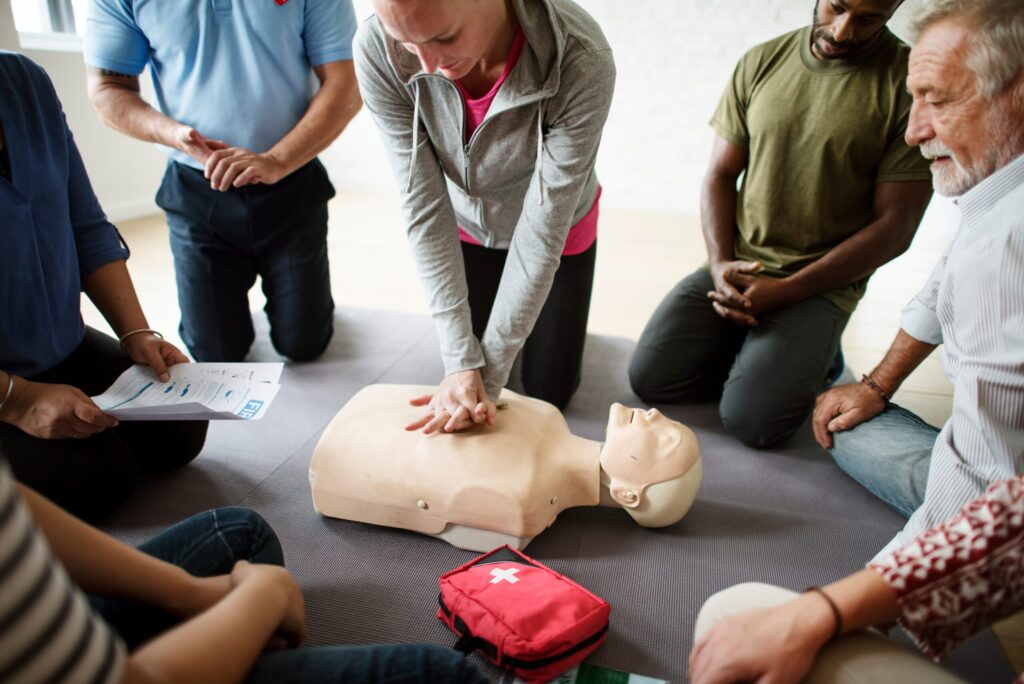Natural disasters can happen at any time and put people, property, and health at great risk. No matter what kind of disaster it is—a hurricane, an earthquake, a flood, or a wildfire—workplaces need to be ready to protect their workers. Making sure that all workers can get full first aid training is one of the most important parts of being ready for a disaster. This piece will talk about why first aid training is important during natural disasters and how companies can get their employees ready for these kinds of situations.
The Importance of First Aid Training in the Workplace
Not only is learning first aid useful for treating everyday accidents, but it’s also very important to know how to help people in an emergency. When a natural disaster happens, first responders might not be able to get to places right away, especially if they are far away or have been hit hard. When these things happen, workers who know how to give first aid can help right away, which can save lives and make accidents less serious until help arrives.
An important part of any plan to be ready for a crisis should be “First Aid Training in the Workplace?” When there is an emergency, employees who know how to treat injuries, do CPR, or even more advanced medical treatments can make a big difference in how many of their coworkers survive. For instance, understanding how to stop bleeding, treat burns, or keep a person stable until help arrives can help them get better faster and avoid more problems.
First Aid Training: A Lifesaver in Natural Disasters
When preparing for natural disasters, businesses need to recognize the various potential risks and injuries that may occur. For example, during earthquakes, employees may sustain broken bones, cuts, or even more serious trauma from falling objects. Floods can result in drowning, hypothermia, or waterborne diseases, while wildfires can cause burns, smoke inhalation, or dehydration.
Employees who have been trained in first aid are ready to act quickly and successfully in these situations. A well-trained staff can handle injuries and give instant care, which is very important after a disaster when professional medical teams may be too busy to help everyone. In addition, teaching workers first aid lets them help each other, which builds teamwork and resilience during tough times.
The Role of Specialized First Aid Courses
While general first aid training is essential for all employees, certain workplaces may benefit from more specialized courses tailored to specific needs. For instance, organizations in sectors that involve high-risk activities, such as construction or manufacturing, may want to ensure their employees receive advanced first aid training. On the other hand, organizations that work with children, such as schools or daycare centers, would benefit from enrolling employees in a Childcare First Aid Course.
The goal of a Childcare First Aid Course is to teach workers how to handle medical situations involving children, which is very important for places of work that work with kids. This class teaches everything from CPR for babies and children to how to handle common injuries in kids, like choking, burns, and allergic reactions. If you train your staff in first aid for babysitting, you can be sure that the kids in your care will get the best care possible in an emergency.
How to Implement First Aid Training for All Employees
It is important to make sure that your workplace is ready for natural disasters by giving all of your workers thorough first aid training. Here are some steps to consider:
- Assess Your Needs: Consider the size of your workforce, the nature of your business, and the potential risks associated with your location. For example, a coastal company may face the risk of hurricanes, while a business in an earthquake-prone area needs training specific to seismic events.
- Provide Comprehensive Training: Offer both basic and advanced first aid courses to cover a range of potential injuries. A well-rounded training program should teach employees how to manage cuts, burns, fractures, and more severe trauma, as well as provide CPR and administer first aid for heart attacks or strokes.
- Include Specialized Courses: In addition to general first aid training, consider offering specialized courses like the Childcare First Aid Course if your workforce interacts with children. Specialized courses can provide more in-depth knowledge and preparation for specific emergency scenarios.
- Regular Refresher Courses: First aid knowledge can become outdated over time. Ensure that employees undergo refresher courses every year or two to stay updated on the latest practices and techniques.
- Create a Disaster Response Plan: First aid training should be a part of a larger disaster reaction plan that includes places to stay, how to get out of the area, and who to call in case of an emergency. Make sure that every worker knows the plan and what they need to do in case of an emergency.
Conclusion
In conclusion, preparing for natural disasters is not just about having the right equipment and evacuation procedures in place; it’s also about ensuring that your employees are well-trained to respond effectively in an emergency. First aid training in the workplace equips your team with the skills needed to handle injuries, provide life-saving care, and ensure the well-being of colleagues in critical situations. Offering specialized training, such as a Childcare First Aid Course, can further enhance preparedness for specific types of emergencies. By investing in comprehensive first aid training for all employees, businesses can create a safer, more resilient workplace ready to face the challenges posed by natural disasters.





